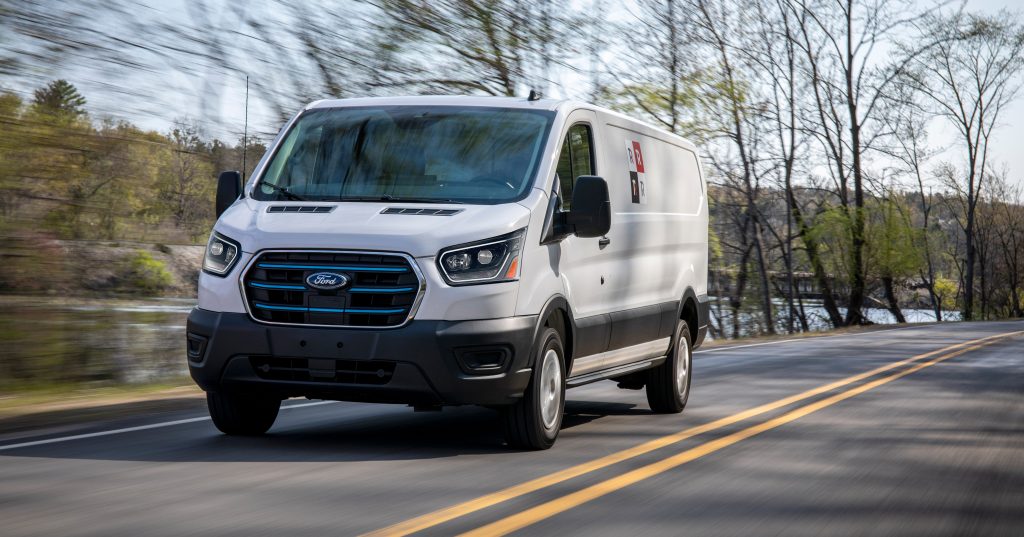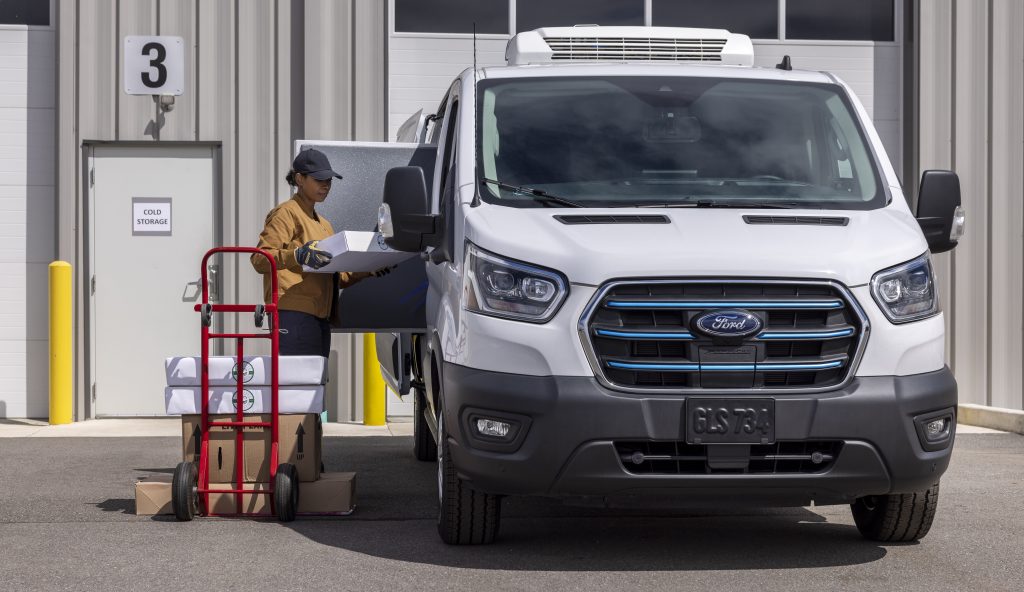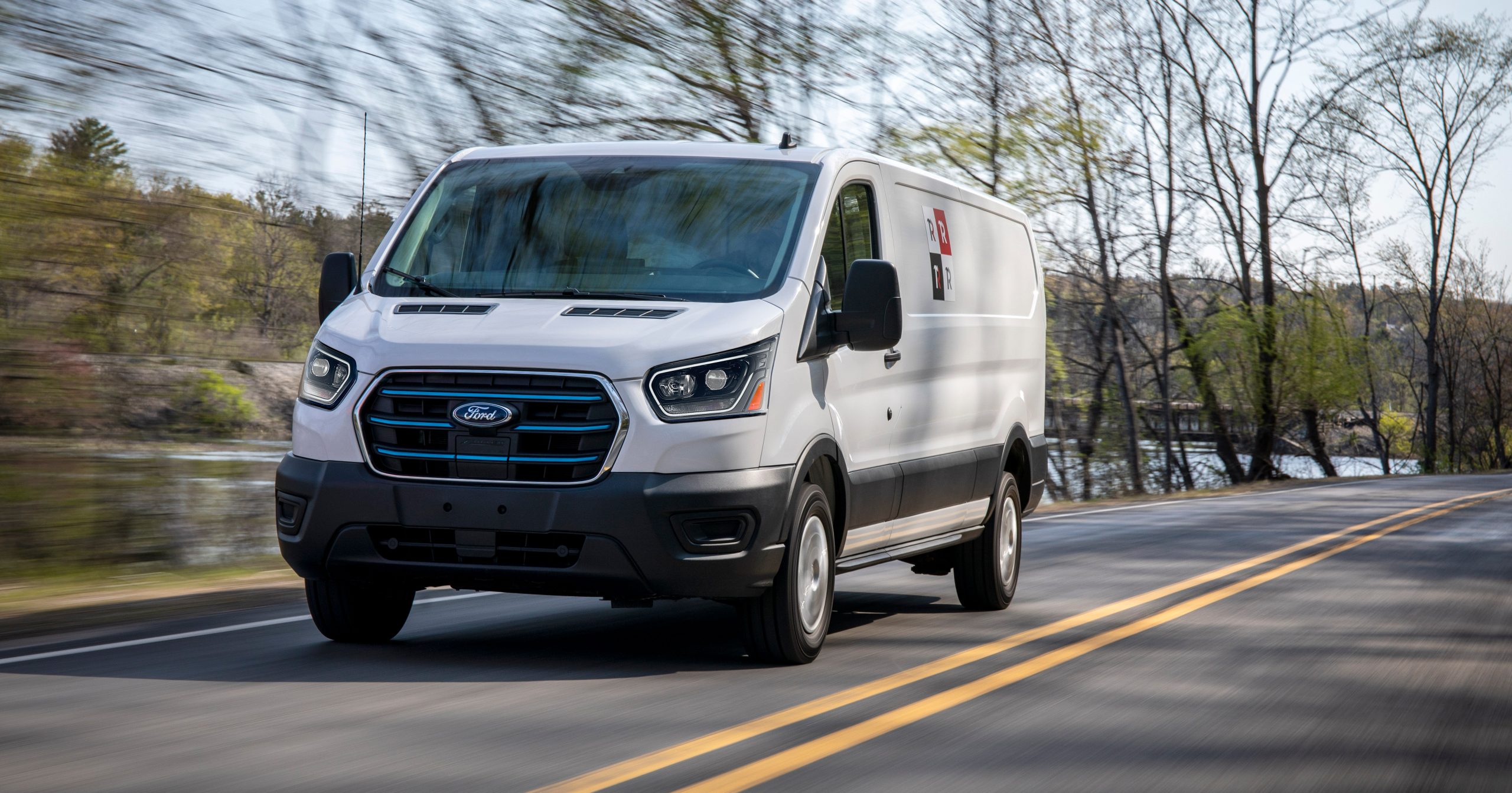
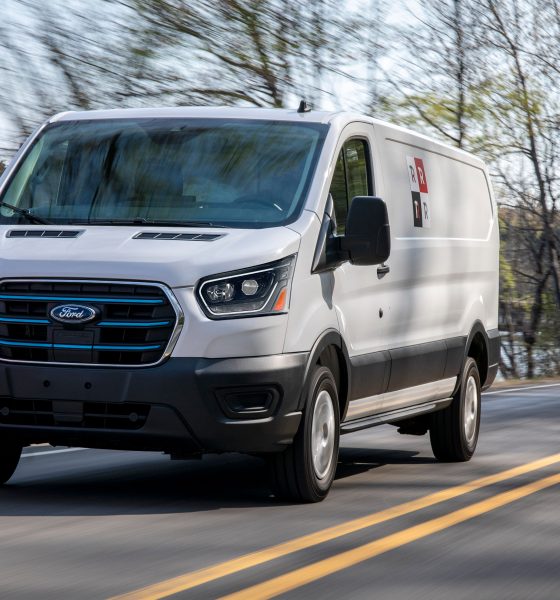
News
Ford launches new E-Transit Enhanced Range
Ford has launched its new E-Transit and has started shipping the vehicle across North America to customers.
Yesterday, Ford officially started getting the new E-Transit, which has a better range rating, lower cost of ownership, and better charging than ever before, to customers as it continues to be a leader in commercial EVs.
The E-Transit is one of the best-selling commercial electric vans in the country, and is truly only challenged by the Mercedes-Benz eSprinter.
- New for 2024 E-Transit, Ford Pro enhances range capability by up to 32% with an estimated range of 159 miles on cargo van low-roof models with an enhanced range high-voltage battery, keeping your business running farther. (Available late 2024.)
- Taking your business farther, the new 2024 E-Transit with enhanced range supports work covering longer distances and provides more capability to unlock electric solutions for new use cases, like refrigerated delivery. (Available late 2024. Optional and aftermarket equipment shown.)
Ford felt it necessary to continue refining the E-Transit as it has already been a suitable choice for business owners who want to cut down on fuel consumption and help with sustainability.
The 2024 E-Transit with Enhanced Range now provides up to 159 miles of driving with 89 kWh of usable energy. This will help support work over longer distances and more capability for use cases like refrigeration.
These types of specific needs consume energy and deplete range. Ford aimed to fix that with the new Enhanced Range version.
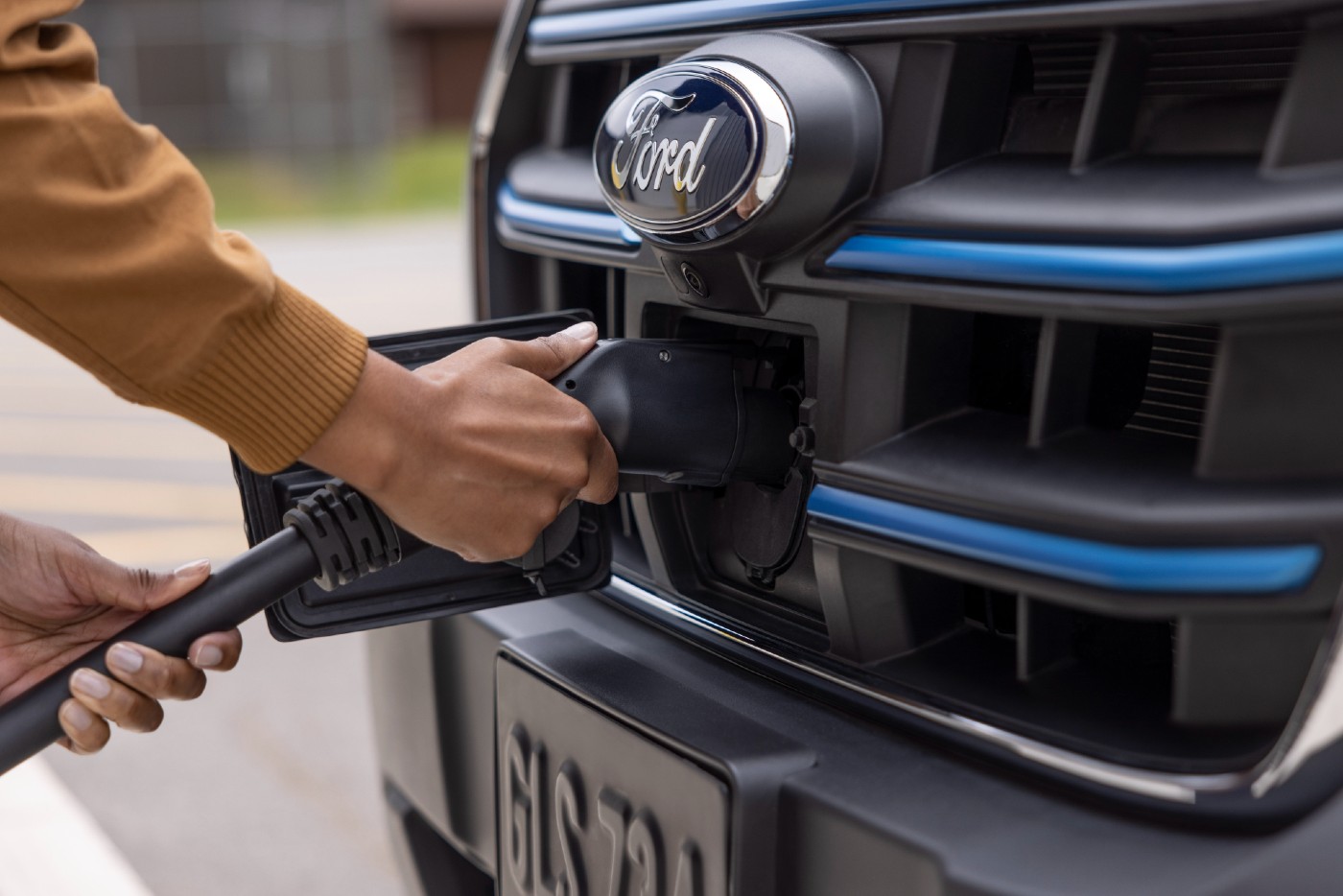
There is a 32 percent increase in range, and now, thanks to dual onboard chargers, there are faster charging times, helping you get back to work quicker.
Additionally, there is 2.4 kW of Pro Power Onboard, which is now operable while the E-Transit is in motion.
Ford did a rundown of some of the E-Transit Enhanced Range’s new features:
- Enhanced-Range Battery: Enhanced range capability provides an estimated range of up to 159 miles with 89 kWh of usable energy, supporting work over longer distances and more capability for new use cases, like refrigerated delivery.
- Cutting-Edge Charging Capabilities: Now featuring dual onboard chargers delivering a charge time that’s 22% faster than before when using Ford Pro’s 80A Series 2 charger and available Ford Pro charging software to help identify the best times to charge and more.
- Lower Total Cost of Ownership: E-Transit helps fleets reduce their total cost of ownership, championed as the Best Fleet Value in America in its category by Vincentric for the third consecutive year thanks to reduced fuel, maintenance and operating costs.
- Sustainability Powerhouse: E-Transit has saved over 3 million gallons of gas and reduced CO2 emissions by more than 25 million kilograms, the equivalent of planting 413,377 tree seedlings and letting them grow for 10 years.
The E-Transit has been one reason Ford has been able to garner a reputation as one of the best-selling EV brands in the country.
As the F-150 Lightning and Mustang Mach-E continue to lead the way, Ford’s E-Transit is truly one of the most suitable commercial EVs on the market.
Despite the company scaling back some of its EV plans and prioritizing hybrids alongside pure electric cars, Ford still remains committed to delivering a great product with its sustainable powertrains.
I’d love to hear from you! If you have any comments, concerns, or questions, please email me at joey@teslarati.com. You can also reach me on Twitter @KlenderJoey, or if you have news tips, you can email us at tips@teslarati.com.

News
Tesla aims to combat common Full Self-Driving problem with new patent
Tesla writes in the patent that its autonomous and semi-autonomous vehicles are heavily reliant on camera systems to navigate and interact with their environment.

Tesla is aiming to combat a common Full Self-Driving problem with a new patent.
One issue with Tesla’s vision-based approach is that sunlight glare can become a troublesome element of everyday travel. Full Self-Driving is certainly an amazing technology, but there are still things Tesla is aiming to figure out with its development.
Unfortunately, it is extremely difficult to get around this issue, and even humans need ways to combat it when they’re driving, as we commonly use sunglasses or sun visors to give us better visibility.
Cameras obviously do not have these ways to fight sunglare, but a new patent Tesla recently had published aims to fight this through a “glare shield.”
Tesla writes in the patent that its autonomous and semi-autonomous vehicles are heavily reliant on camera systems to navigate and interact with their environment.

The ability to see surroundings is crucial for accurate performance, and glare is one element of interference that has yet to be confronted.
Tesla described the patent, which will utilize “a textured surface composed of an array of micro-cones, or cone-shaped formations, which serve to scatter incident light in various directions, thereby reducing glare and improving camera vision.”

The patent was first spotted by Not a Tesla App.
The design of the micro-cones is the first element of the puzzle to fight the excess glare. The patent says they are “optimized in size, angle, and orientation to minimize Total Hemispherical Reflectance (THR) and reflection penalty, enhancing the camera’s ability to accurately interpret visual data.”
Additionally, there is an electromechanical system for dynamic orientation adjustment, which will allow the micro-cones to move based on the angle of external light sources.
This is not the only thing Tesla is mulling to resolve issues with sunlight glare, as it has also worked on two other ways to combat the problem. One thing the company has discussed is a direct photon count.
CEO Elon Musk said during the Q2 Earnings Call:
“We use an approach which is direct photon count. When you see a processed image, so the image that goes from the sort of photon counter — the silicon photon counter — that then goes through a digital signal processor or image signal processor, that’s normally what happens. And then the image that you see looks all washed out, because if you point the camera at the sun, the post-processing of the photon counting washes things out.”
Future Hardware iterations, like Hardware 5 and Hardware 6, could also integrate better solutions for the sunglare issue, such as neutral density filters or heated lenses, aiming to solve glare more effectively.
Elon Musk
Delaware Supreme Court reinstates Elon Musk’s 2018 Tesla CEO pay package
The unanimous decision criticized the prior total rescission as “improper and inequitable,” arguing that it left Musk uncompensated for six years of transformative leadership at Tesla.

The Delaware Supreme Court has overturned a lower court ruling, reinstating Elon Musk’s 2018 compensation package originally valued at $56 billion but now worth approximately $139 billion due to Tesla’s soaring stock price.
The unanimous decision criticized the prior total rescission as “improper and inequitable,” arguing that it left Musk uncompensated for six years of transformative leadership at Tesla. Musk quickly celebrated the outcome on X, stating that he felt “vindicated.” He also shared his gratitude to TSLA shareholders.
Delaware Supreme Court makes a decision
In a 49-page ruling Friday, the Delaware Supreme Court reversed Chancellor Kathaleen McCormick’s 2024 decision that voided the 2018 package over alleged board conflicts and inadequate shareholder disclosures. The high court acknowledged varying views on liability but agreed rescission was excessive, stating it “leaves Musk uncompensated for his time and efforts over a period of six years.”
The 2018 plan granted Musk options on about 304 million shares upon hitting aggressive milestones, all of which were achieved ahead of time. Shareholders overwhelmingly approved it initially in 2018 and ratified it once again in 2024 after the Delaware lower court struck it down. The case against Musk’s 2018 pay package was filed by plaintiff Richard Tornetta, who held just nine shares when the compensation plan was approved.
A hard-fought victory
As noted in a Reuters report, Tesla’s win avoids a potential $26 billion earnings hit from replacing the award at current prices. Tesla, now Texas-incorporated, had hedged with interim plans, including a November 2025 shareholder-approved package potentially worth $878 billion tied to Robotaxi and Optimus goals and other extremely aggressive operational milestones.
The saga surrounding Elon Musk’s 2018 pay package ultimately damaged Delaware’s corporate appeal, prompting a number of high-profile firms, such as Dropbox, Roblox, Trade Desk, and Coinbase, to follow Tesla’s exodus out of the state. What added more fuel to the issue was the fact that Tornetta’s legal team, following the lower court’s 2024 decision, demanded a fee request of more than $5.1 billion worth of TSLA stock, which was equal to an hourly rate of over $200,000.
Delaware Supreme Court Elon Musk 2018 Pay Package by Simon Alvarez
News
Tesla Cybercab tests are going on overdrive with production-ready units
Tesla is ramping its real-world tests of the Cybercab, with multiple sightings of the vehicle being reported across social media this week.

Tesla is ramping its real-world tests of the Cybercab, with multiple sightings of the autonomous two-seater being reported across social media this week. Based on videos of the vehicle that have been shared online, it appears that Cybercab tests are underway across multiple states.
Recent Cybercab sightings
Reports of Cybercab tests have ramped this week, with a vehicle that looked like a production-ready prototype being spotted at Apple’s Visitor Center in California. The vehicle in this sighting was interesting as it was equipped with a steering wheel. The vehicle also featured some changes to the design of its brake lights.
The Cybercab was also filmed testing at the Fremont factory’s test track, which also seemed to involve a vehicle that looked production-ready. This also seemed to be the case for a Cybercab that was spotted in Austin, Texas, which happened to be undergoing real-world tests. Overall, these sightings suggest that Cybercab testing is fully underway, and the vehicle is really moving towards production.
Production design all but finalized?
Recently, a near-production-ready Cybercab was showcased at Tesla’s Santana Row showroom in San Jose. The vehicle was equipped with frameless windows, dual windshield wipers, powered butterfly door struts, an extended front splitter, an updated lightbar, new wheel covers, and a license plate bracket. Interior updates include redesigned dash/door panels, refined seats with center cupholders, updated carpet, and what appeared to be improved legroom.
There seems to be a pretty good chance that the Cybercab’s design has been all but finalized, at least considering Elon Musk’s comments at the 2025 Annual Shareholder Meeting. During the event, Musk confirmed that the vehicle will enter production around April 2026, and its production targets will be quite ambitious.
